Review: Trekking the Great Wall of China
Jinshanling is the best preserved part of China's Great Wall, with many of its original features dating back to 1570. Joe Minihane treks through steep icy paths along this section of one of the Seven Wonders of the World.
Hefting myself up over the final steep step, it's the isolation that hits me first. I stand tall and take in the scene: a winding trail which snakes across the tallest peaks in both directions, covered in snow and ice, with just my tour companions and some hardy souvenir sellers for company.
This is the Great Wall of China at Jinshanling. A four-hour drive northeast from central Beijing, this 10km (6 mile) section of China’s most stunning historical site is the ideal destination for those who want to see the crumbling, ancient ruin as it once was.
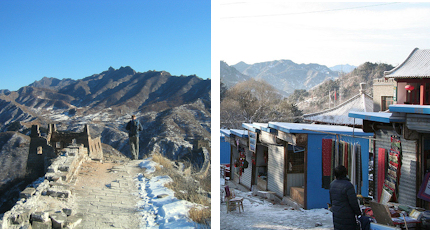 Street vendors greet you as you set off on your journey
Street vendors greet you as you set off on your journeyCreative Commons / dringer / numb3r
While hawkers trail our every move, they are far less insistent and fewer in number than at the vast tourist hub at the Badaling section. The latter, largely rebuilt and geared up for time-pressed travellers, lacks the soul of this long stretch, especially in the depths of freezing February.
We strike out north, carefully keeping to the centre of the wall, avoiding the open, precipitous drops, some as much as 30m (98ft) down to sparse brush and pine forest. The winter ice has made this normally brisk stroll far more arduous and our guides, plus those hardy hawkers, help us pick our way along the stones and away from the danger of black ice.
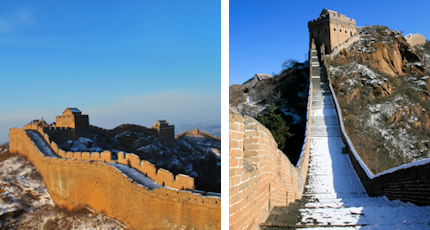 The steep winding steps of Jinshanling
The steep winding steps of JinshanlingiStockphoto / Thinkstock
As the wall climbs at a spectacular gradient, each tower offers more stunning, sky-filling views. Using gloved hands to clamber up steep, foot-high steps, we emerge onto roofs which feel as if they are at the top of the world. It's no wonder this wall kept marauding invaders out for centuries. The sheer scale of it is virtually impossible to get your mind around, especially on a clear winter's day where the wall reaches out to the horizon on sharp mountain ridges.
The path continues, with fierce drops down to low-lying access points needing to be negotiated before climbing back up to the main route. Our 16-strong group, each now with a hawker in tow pointing out where to place our tentative feet, feels its way gingerly to higher points.
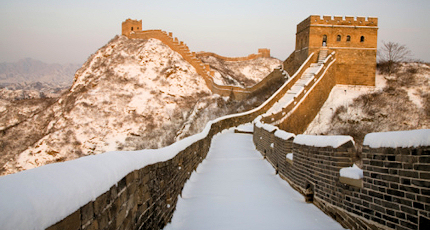 A snowy path to one of the 67 lookout towers
A snowy path to one of the 67 lookout towersiStockphoto / Thinkstock
This initial section has been restored slightly, although not in the theme park-style at Badaling, so it retains the historical vibe for which Jinshanling is rightly famed. Each of the 67 towers on this stretch has its own character and while they have been touched up slightly, there's little to suggest that the job ensured that the huge drops and dangerously missing bricks were taken care of.
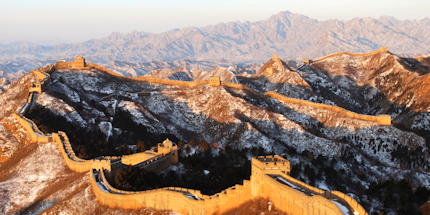 The arduous journey rewards you with stunning mountain views
The arduous journey rewards you with stunning mountain viewsiStockphoto / Thinkstock
The views become progressively more spellbinding until we reach our highest point. It's here that we look on to the untouched, faded glory of the wall as it reaches out to Simatai. This section has been closed under orders of the Chinese government since the summer of 2010. Politicians and conservationists were wary that walkers along this stretch were exacerbating its already fragile state. Renovation work is under way, with rumours that the wall here will reopen later this year.
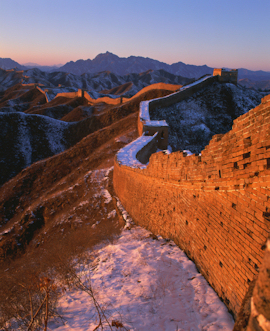 The sun sets over the Great Wall
The sun sets over the Great WalliStockphoto / Thinkstock
Unfortunately, it means that rather than completing the walk from Jinshanling to Simatai, we must return the way we came. As much of this is downhill, and with the icy conditions under foot, we find ourselves on our back sides, easing down using our hands to prevent any nasty falls. At least this way we can look up and enjoy the snow-flecked wall as it falls slowly before us.
Returning to our entry point, I take one final glimpse of the snowy steps and begin my descent back to the minibus on a cramped, tired journey through the smoggy outskirts of the Chinese capital. But coming all this way and missing out on Badaling's faux authenticity makes that lengthy ride all the more worthwhile.
IDEAL FOR...
Those who want to see the Great Wall of China in, or as close to, its original state as possible. The tour group was made up of a wide age group, from gap year students to 30-something adventurers and businessmen on a day off from work in Beijing. If you want isolation on the Great Wall, going during the winter is perfect.
WORTH THE PRICE?
At around £40 (¥370) for an entire day, including transport, entry fee, a guide and food at a small restaurant near the foot of the wall, this trip is exceedingly good value. For a chance to see the Great Wall away from the crowds, you'll struggle to find anything better for less.
ROOM FOR IMPROVEMENT
The drive out takes a long time and Beijing traffic can be horrific. Especially as you leave, as the roads get busy at around 6am, while the return trip is around 8pm when everyone's heading home from work. The McDonald's breakfast provided is hardly filling either and not ideal for veggies or those who prefer something healthy first thing.
TIPS
Be sure to wear sturdy footwear (i.e. trail shoes or walking boots) no matter what time of year you go. The path is steep and can be strenuous, so if you're unfit or can't face five hours on your feet, then maybe this one isn't for you.
If you're visiting in winter, pack extra layers and bundle up. The temperature in February fell to an icy -10ºC (14ºF) during the day, so a hat and gloves are essential. And if you don't fancy that Sausage and Egg McMuffin, go to the supermarket the night before and stock up on fruit and breakfast bits.
RATING: 4/5
DETAILS
Starting point: Picks up at several hostels and hotels across Beijing.
Times: Daily with departure at 6am.
Price: £33 + £6 entrance fee (¥308 + ¥49).
www.china365inn.com/html_products/Jinshanling-Hiking-Tour-10.html
Do you have any Feedback about this page?
© 2025 Columbus Travel Media Ltd. All rights reserved. No part of this site may be reproduced without our written permission, click here for information on Columbus Content Solutions.









 You know where
You know where